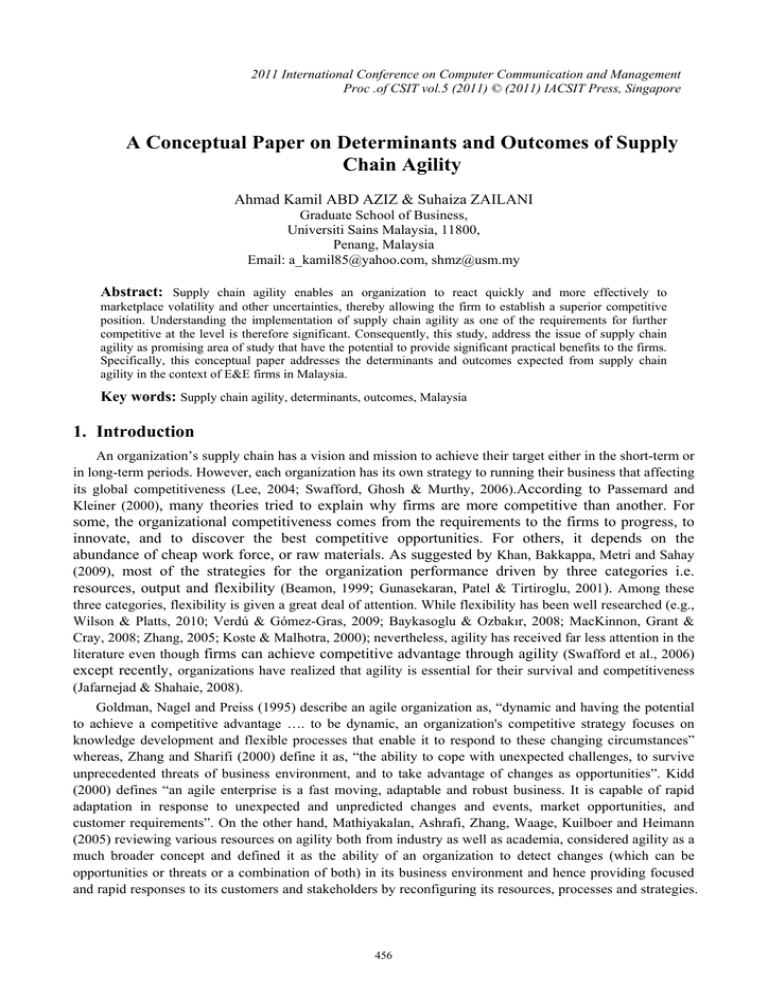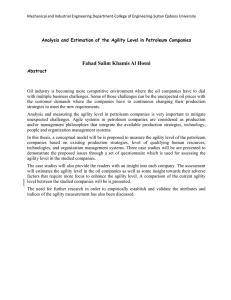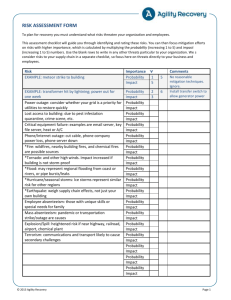Document 13134463
advertisement

2011 International Conference on Computer Communication and Management Proc .of CSIT vol.5 (2011) © (2011) IACSIT Press, Singapore A Conceptual Paper on Determinants and Outcomes of Supply Chain Agility Ahmad Kamil ABD AZIZ & Suhaiza ZAILANI Graduate School of Business, Universiti Sains Malaysia, 11800, Penang, Malaysia Email: a_kamil85@yahoo.com, shmz@usm.my Abstract: Supply chain agility enables an organization to react quickly and more effectively to marketplace volatility and other uncertainties, thereby allowing the firm to establish a superior competitive position. Understanding the implementation of supply chain agility as one of the requirements for further competitive at the level is therefore significant. Consequently, this study, address the issue of supply chain agility as promising area of study that have the potential to provide significant practical benefits to the firms. Specifically, this conceptual paper addresses the determinants and outcomes expected from supply chain agility in the context of E&E firms in Malaysia. Key words: Supply chain agility, determinants, outcomes, Malaysia 1. Introduction An organization’s supply chain has a vision and mission to achieve their target either in the short-term or in long-term periods. However, each organization has its own strategy to running their business that affecting its global competitiveness (Lee, 2004; Swafford, Ghosh & Murthy, 2006).According to Passemard and Kleiner (2000), many theories tried to explain why firms are more competitive than another. For some, the organizational competitiveness comes from the requirements to the firms to progress, to innovate, and to discover the best competitive opportunities. For others, it depends on the abundance of cheap work force, or raw materials. As suggested by Khan, Bakkappa, Metri and Sahay (2009), most of the strategies for the organization performance driven by three categories i.e. resources, output and flexibility (Beamon, 1999; Gunasekaran, Patel & Tirtiroglu, 2001). Among these three categories, flexibility is given a great deal of attention. While flexibility has been well researched (e.g., Wilson & Platts, 2010; Verdú & Gómez-Gras, 2009; Baykasoglu & Ozbakır, 2008; MacKinnon, Grant & Cray, 2008; Zhang, 2005; Koste & Malhotra, 2000); nevertheless, agility has received far less attention in the literature even though firms can achieve competitive advantage through agility (Swafford et al., 2006) except recently, organizations have realized that agility is essential for their survival and competitiveness (Jafarnejad & Shahaie, 2008). Goldman, Nagel and Preiss (1995) describe an agile organization as, “dynamic and having the potential to achieve a competitive advantage …. to be dynamic, an organization's competitive strategy focuses on knowledge development and flexible processes that enable it to respond to these changing circumstances” whereas, Zhang and Sharifi (2000) define it as, “the ability to cope with unexpected challenges, to survive unprecedented threats of business environment, and to take advantage of changes as opportunities”. Kidd (2000) defines “an agile enterprise is a fast moving, adaptable and robust business. It is capable of rapid adaptation in response to unexpected and unpredicted changes and events, market opportunities, and customer requirements”. On the other hand, Mathiyakalan, Ashrafi, Zhang, Waage, Kuilboer and Heimann (2005) reviewing various resources on agility both from industry as well as academia, considered agility as a much broader concept and defined it as the ability of an organization to detect changes (which can be opportunities or threats or a combination of both) in its business environment and hence providing focused and rapid responses to its customers and stakeholders by reconfiguring its resources, processes and strategies. 456 Since organizational agility involves many diverse issues, this study focuses on identifying the determinants and outcomes of agility in an organization's supply chain. Implementing a concept of agility in the supply chain enables a manufacturing firm to achieve higher levels of overall organizational agility (Swafford et al., 2006). Swafford et al., (2006) highlight that supply chain agility enables an organization to react quickly and more effectively to marketplace volatility and other uncertainties, thereby allowing the firm to establish a superior competitive position. In addition, the agile supply chain processes are more market sensitive, enhanced capable to synchronizing supply with the real-time demand change and make quick response to the firms (Helo, Xiao & Jiao, 2006). Given that an organization's supply chain agility directly impacts its ability to produce innovative products and deliver them to their customers; it is believed an organization's supply chain agility is a critical factor affecting its overall competitiveness. Previous studies have been done to see the relationship between supply chain agility, firm performance and competitive advantage (Loppacher, Cagliano & Spina, 2010; Betts & Tadisina, 2009; Lin & Tsai, 2009; Olugu & Wong, 2009; Landua, 2008; Javalgi, Radulovich, Pendleton & Scherer, 2005). The increase in competitive advantage and firm performance can improve the level of implementation of supply chain practices (Lin, Chiu & Chu, 2006). Li, Ragu-Nathan, Subba and Ragu-Nathan (2006) also states the firms that will achieve a high level of competitive advantage and a high impact use of supply chain practices not only can be viewed and assessed through the achievement of the firm but also the competitive advantage offered by the firm. With regards to supply chain agility, it can provide a positive influenced to the company by the environment of competitive and information technology, and consequently it influence supply chain performance and finally competitive advantage. Therefore, agility is highlighted as the system feature of the “best” supply chains (Lee, 2004). Accordingly, supply chain agility is important for providing economic and competitive benefits to organizations. The importance and value of supply chain agility motivated the study to explore more on this topic and shed some light on it as a promising area of study and practice. This conceptual paper introduces the importance of supply chain agility and other related topics. The paper continues to explain the framework and hypothesis development. The methodology and conclusion end the paper. 2. Literature Review 2.1 Supply Chain Agility A new paradigm kwon as “agility” is being as the solution related to maintaining competitive advantage and enable to collaborate in order to achieve mutually agreed on goals (Zhang & Sharifi, 2000). This is because agility is perceived as a vital characteristic that supply chain firms need in order to maintain their competitiveness. Agility can be defined as the ability of an organization to adapt and react to unexpected or unforeseen changes is critical to achieving and maintaining a competitive advantage (Ganguly, Nilchiani & Farr, 2009). According to Swafford et al., (2006), organizational agility can provides the capability to the organization to embed the changes in the marketplace and exploit market opportunities with speed and quickness. Lee (2004) determined that agility can be defined as a response to short term changes in demand or supply quickly and can control disruptions external smoothly. 2.2 Dimensions on Supply Chain Agility According to Swafford et al., (2006), supply chain agility must have instrument to measure the effectiveness this tool because without such an instrument, researchers cannot provide a foundation for expanding the theories regarding causal links among supply chain agility practices, capabilities and performance outcomes. In sum, a key agenda for supply chain research and practice is the development of instruments that predict and explain organization practices, in which supply chain agility is embedded. To that end, this research reports the results of a study that developed and validated a measurement instrument that can be used in future supply chain agility research. Severe competition in today’s business environment force companies to fully dynamic and unpredictable processes to improve and optimize manufacturing performance in order to be able to compete in competition. The reaction and agility become more important characteristics of supply chain firms. Thus, the process in supply chain must be designed optimally by taking into account reaction and agility related measures in order to improve effectiveness and performance. Wilson 457 and Platts (2010) state that flexibility has been identifies as an important criteria to provides the ability to the firms to deal with uncertainty changes in today’s business environments. This statement is also consistent with Cousens, Szwejczewski and Sweeney (2009) and Bernardes and Hanna (2009), where they view flexibility as a key competitive capability and advantage for supply chain agility firms to satisfy different customer needs. By using SCPR model, this study will study the agility from procurement, manufacturing and distribution flexibility. 2.3 Determinants of Supply Chain Agility Rajagopal, Zailani and Sulaiman (2009) reported the data and information was derived from secondary literature search as well as the input from supply chain practitioners, the study developed the following list of supply chain determinants: (i) Information Flow, (ii) Supply Chain Infrastructure, (iii) Organizational Linkage, and (iv) Resource Sharing. Each of the determinants has its own set of attributes each with the critical components and the determinants that need to be in place if supply chain initiatives are to succeed. 2.4 Supply Chain Performance Literature also indicated that there are various ways to measure supply chain performance. Swafford et al., (2006) proposed using the supply chain operations reference (SCOR) model to measure supply chain performance. SCOR model consists of five distinctive process categories, plan, and sources, make, deliver and return but these components correspond to the source, make and deliver processes. This measurement involves the performance attributes for level 1 metrics are reliability, responsiveness, flexibility, cost and asset (Supply Chain Council, 2005). 2.5 Competitive Advantage The most common models to the research of competitive advantage are in economic theory, which is a typical market-based model. It focuses on achieving competitive advantage through Porter three generic strategies i.e. (i) overall cost leadership; (ii) differentiation; and (iii) focus. This theory of competitive advantage is mainly driven by external factors. Conversely, the second model, which centers on the firms resources and is driven by factors that are internal to the organization, mainly focuses attention both on the resources endowments of firms and on the characteristics of resources that cause asymmetries to persist (Reed, Lemak & Mero, 2000; Fahy, 2002). This study uses these four components basic factors of Distinctive Competencies which is efficiency; quality; innovation; and customer response as parts of competitive advantage. According to Lin and Tsai (2009), a company following these four basic rules (efficiency, quality, innovation and customer response) may succeed in cost leadership and differentiation, and finally obtain competitive advantage. 3. Methodology The target population of this study is made up of all 646 Electrical and Electronics (E&E) firms from Malaysia. The sample firms were drawn through simple random sampling from the list obtained from the Federal Malaysian Manufacturers (FMM) (Fmm-Matrade, 2010). The questionnaire will be answered by the supply chain / purchasing / procurement managers within the Electrical and Electronics (E&E) firm on the adoption of supply chain agility. In order to facilitate investigation of the supply chain agility in influencing creation of supply chain performance, which in turn, assisting the organization in creating the competitive advantage, the study has developed a variety of measures for each variable based on the previous literature works, inclusive of those established under self-construct. In this study, supply chain agility follow suit the three critical processes of the supply chain, namely procurement/sourcing, manufacturing and logistics/distribution. Supply chain performance can be viewed from five dimensions namely reliability, responsiveness, flexibility, cost and asset. Competitive advantage, on the other hand, can be measured from four dimensions namely efficiency, quality, innovation and customer response. Questions for all dimensions will be evaluated by using a 5-point Likert scale ranging and analyzed by using Statistical Software Package, SPSS 17.0 to find first the significant principal components, and then their correlation and coefficient of determination R2, goodness of measures, and follows by the reliability analysis. 458 4. CONCLUSIONS This paper addressed the importance of supply chain agility which includes the firm’s suppliers’ and customers’ supply chain processes. The study is expected to enhance the knowledge and performance of managers in business and public organizations in the following ways. First, managers should fully understand, at a minimum, the importance of supply chain agility and competitive advantage discussed in this report. Managers must take this opportunity as a strategy to be agile in the business in terms of demand and supply for their markets. Therefore, managers must have the ability to meet uncertainty consumer requirements by implementing this strategy in order to sustain the company’s wealth creation (Mohd Yusof, Tengku Mohd Azzman & Mohd Zawawi, 1991). Thus, this study is an important initial step in understanding the model of supply chain agility strategies. This understanding can help managers design appropriate policies for the implementation of supply chain agility in their organizations 5. References [1] Baykasoglu, A., & Ozbakır, L. (2008). Analysing the effect of flexibility on manufacturing systems performance. Journal of Manufacturing Technology Management, 19 (2), 172-193. [2] Beamon, B. M. (1999). Measuring Supply Chain Performance. International Journal of Operation and Production Management, 19 (3), 275-292. [3] Bernardes, E. S., & Hanna, M. D. (2009). A theoretical review of flexibility, agility and responsiveness in the operations management literature toward a conceptual definition of customer responsiveness. International Journal of Operations & Production Management, 29 (1), 30-53. [4] Betts, T., & Tadisina, S. K. (2009). Supply chain agility, collaboration and performance: how do they relate? POMS 20th Annual Conference. Orlando, Florida U.S.A.: Department of Management, Southern Illinios University. [5] Cousens, A., Szwejczewski, M., & Sweeney, M. (2009). A process for managing manufacturing flexibility. International Journal of Operations & Production Management, 29 (4), 357-385. [6] Fahy, J. (2002). A Resource-based analysis of sustainable competitive advantage in a global environment. International Business Review, 57-78. [7] Fmm-Matrade. (2010). Federation of Malaysian Manufacturers Directory - Electrical & Electronics (41st ed.). Kuala Lumpur, Malaysia: Percetakan Orkid Sdn Bhd. [8] Ganguly, A., Nilchiani, R., & Farr, J. V. (2009). Evaluating agility in corporate enterprises. International Journal of Production Economics, 410-423. [9] Goldman, S. L., Nagel, R. N., & Preiss, K. (1995). Agile competitors and virtual organizations: strategies for enriching the customer. New York: Van Nostrand Reinhold, New York. [10] Gunasekaran, A., Patel, C., & Tirtiroglu, E. (2001). Performance measures and metrics in a supply chain environment. International Journal of Operations & Production Management, 71-87. [11] Helo, P., Xiao, Y., & Jiao, J. R. (2006). A web-based logistics management system for agile supply demand network design. Journal of Manufacturing Technology Management, 17 (8), 1058-1077. [12] Jafarnejad, A., & Shahaie, B. (2008). Evaluating and improving organizational agility. Delhi Business Review, 9 (1). [13] Javalgi, R. G., Radulovich, L. P., Pendleton, G., & Scherer, R. F. (2005). Sustainable competitive advantage for internet firms - a strategic framework and implications for global marketers. International Marketing Review, 22 (6), 669-670. [14] Khan, K. A., Bakkappa, B., Metri, B. A., & Sahay, B. (2009). Impact of agile supply chains' delivery practices on firms' performance: cluster analysis and validation. Supply Chain Management: An International Journal, 42. [15] Kidd, P. (2000). Two definitions of agility. http://www.cheshirehenbury.com. [16] Koste, L. L., & Malhotra, M. K. (2000). A theoretical framework for analyzing the dimensions of manufacturing flexibility. Journal of Operations Management, 19, 100-125. 459 [17] Landua, I. (2008). Master thesis: gaining competitive advantage through customer satisfaction, trust and confidence in consideration of the influence of green marketing. Gävle: Department of Business Administration, University of Gävle. [18] Lee, H. L. (2004). The triple-A supply chain. Harvard Business Review, 102. [19] Li, S., Ragu-Nathan, B., Subba, R., & Ragu-Nathan, T. (2006). The Impact of Supply Chain Management Practices on Competitive Advantage and Organizational Performance. The International Journal of Management Science, 107-124. [20] Lin, C.-T., Chiu, H., & Chu, P.-Y. (2006). Agility index in the supply chain. International Journal of Production Economics, 100 (2), 285-299. [21] Lin, Y. C., & Tsai, P. H. (2009). The impact of a global logistics integration system on localization service and business competitive advantage. European Business Review, 21 (5), 418-437. [22] Loppacher, J. S., Cagliano, R., & Spina, G. (2010). Key factors in global supply headquarters-subsidiary control systems. Journal of Manufacturing Technology Managament, 21 (7), 794-817. [23] Lummus, R. R., Duclos, L. K., & Vokurka, R. J. (2003). Supply chain flexibility: building a new model. Global Journal of Flexible Systems Management, 4 (4), 1-13. [24] MacKinnon, W., Grant, G., & Cray, D. (2008). Enterprise information systems and strategic flexibility. Proceedings of the 41st Annual Hawaii International Conference on System Sciences (p. 402). Waikoloa, Big Island, Hawaii: IEEE Computer Society. [25] Mathiyakalan, S., Ashrafi, N., Zhang, W., Waage, F., Kuilboer, J., & Heimann, D. (2005). Defining business agility: an exploratory study. Proceedings of the 16th Information Resources Management Conference, San Diego, CA , 15-18. [26] Olugu, E. U., & Wong, K. Y. (2009). Supply chain performance evaluation: trends and challenges. American Journal of Engineering and Applied Sciences, 2 (1), 202-211. [27] Passemard, D., & Kleiner, B. H. (2000). Competitive advantage in global industries. Management Research News, 111. [28] Rajagopal, P., Zailani, S., & Sulaiman, M. (2009). Assessing the effectiveness of supply chain partnering with scalable partnering as a moderator. International Journal of Physical Distribution & Logistics Management, 649668. [29] Reed, R., Lemak, D. J., & Mero, N. P. (2000). Total quality management and sustainable competitive advantage. Journal of Quality Management, 5 (1), 5-26. [30] Supply Chain Council. (2005). the supply chain operations reference (SCOR) model. http://www.supply-chain.org. [31] Swafford, P. M., Ghosh, S., & Murthy, N. N. (2006). The antecedents of supply chain agility of a firm: scale development and model testing. Journal of Operations Management, 170-88. [32] Verdú, A. J., & Gómez-Gras, J.-M. (2009). Measuring the organizational responsiveness through managerial flexibility. Journal of Organizational Change Management, 22 (6), 668-690. [33] Wilson, S., & Platts, K. (2010). How do companies achieve mix flexibility? International Journal of Operations & Production Management, 30 (9), 978-1003. [34] Zhang, M. J. (2005). Information systems, strategic flexibility and firm performance: an empirical investigation. Journal of Engineering and Technology Management, 22 (3), 163-184. [35] Zhang, Q., Vondermbse, M. A., & Lim, J. S. (2003). Manufacturing flexibility: defining and analyzing [36] Zhang, Z., & Sharifi, H. (2000). A methodology for achieving agility in manufacturing organisations. International Journal of Operations & Production Management, 20 (4), 496-512. 460


